► E-Class vs 5-series saloons
► Petrol 520i takes on diesel E220d
► These might be the last pure-ICE versions…
Bigger and cleverer than ever, the combustion-engined 5-series and E-Class are back for another round of the timeless duel. It might feel like it’s a party on death row, but what a party.
Pre-flight briefing: BMW 520i
Why is it here?
It’s a toss-up whether the 3-series or 5-series is BMW’s core product; if either of them sneezes, its maker comes down with a cold. So the 5-series plays it visually safe, with no rabbit-fang grille or stacked headlights. It’s always been the key E-Class rival, despite Audi’s best efforts, and has traditionally been slightly less luxurious and more driver-focused.
Any clever stuff?
Mercedes chucked out the Comand controller, but this BMW still hangs on to the rotary iDrive interface which lets the driver control secondary functions with zero distraction and 100 per cent reliability. Ergonomic assist is provided by upgraded voice control and two unambiguous rocker switches on the cleaned-up steering wheel.
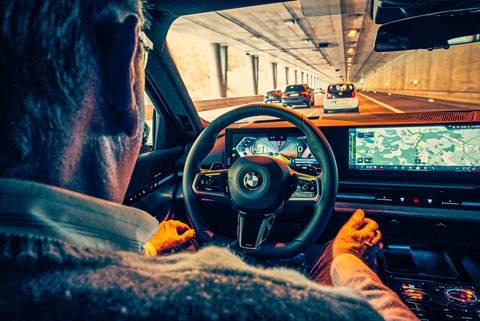
Which version is this?
The £51,000 520i M Sport is the entry-level 5-series. In standard form it’s not as luxurious and overtly techy as the more expensive E-Class. At the moment the 5-series is only available as a saloon and with rear-wheel drive, but the Touring estate version is on its way, and so is xDrive all-wheel drive, which will come with the 550e plug-in hybrid; there’s also a 530e PHEV. Spec choice is M Sport or M Sport Pro. And then there’s the i5, essentially an all-electric 5-series.
Pre-flight briefing: Mercedes-Benz E220d
Why is it here?
Although saloons are fast falling out of favour, the E-Class still holds strong allure for those who like the image and want a mix of luxury and solidity. It’s been going up against the 5-series for generations, but there’s also now a small side tussle going on: does the E actually make the S-Class irrelevant? Most of the bigger car’s features are available here.
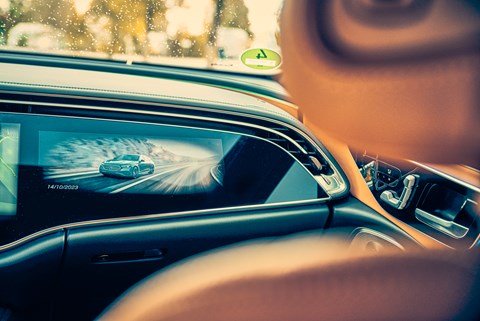
Any clever stuff?
Mechanically, this is an evolution of familiar hardware. But that’s overshadowed by software-driven innovations like the Superscreen and its imposing array of monitors, displays and VR assistants. The seat massage function is superb, especially when combined with other visual, acoustic and olfactory feelgood features. ‘Creating Routines’ cleverly preconditions the vehicle according to factors including temperature, time of day, and destination.
Which version is this?
The E220d AMG Line Premium is £63,050 before options. Same trim but petrol costs £1635 less; the entry-level E200 is £55,290. At this point, neither 4Matic AWD nor six-cylinder engines are available. The top-of-the-line model is currently the E300e PHEV Premium Plus, powered by a 328bhp 2.0-litre engine, priced at £76,585.
Mercedes E-Class vs BMW 5-series: party on death row
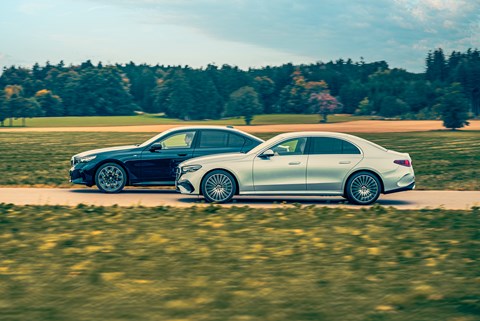
What we took for granted for so long suddenly seems quite exceptional. Two new premium cars, with not a single charging cable between them. But here they are, combustion-engined four-door saloons from BMW and Mercedes; in some ways doing what they’ve done for decades, in other ways very different. To paraphrase Mark Twain, reports of their death have been greatly exaggerated.
In the past, the 5-series and E-Class were flag bearers for two different worlds. The BMW was as a rule the driver’s choice, more involving and dynamic, a sporty car for a clientele who pictured themselves in the fast lane of the autobahn, less so on urban boulevards. The Mercedes was typically a more comfort-orientated status symbol, safety-rich as well as notably plusher inside.
But the lines have recently blurred. Software became the prime innovation driver, AMG started challenging M on all fronts and both marques sped off in the same direction, signposted premium luxury. Both Mercedes and BMW were also developing some unusually risky approaches to design – think EQE and EQS or 4- and 7-series. In the core segment, however, where 3-series and C-Class and 5-series and E-Class compete, the rivals still play it safe.
And yet when you open the door and step inside the 520i or the E220d, nothing is the way it was, and not every change is for the better. The new BMW looks almost anonymous inside, a hi-res gaming console with steering wheel attached, a couple of tablets next to each other plus a head-up display and a shiny centre stack not unlike the elaborate control panel for a high-end home entertainment system.
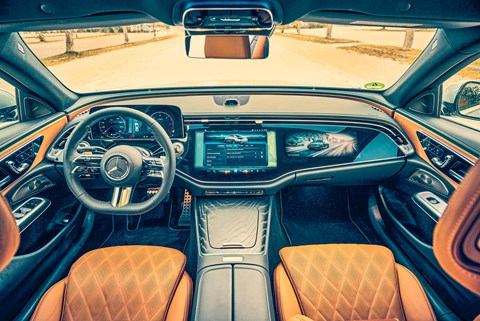
Our Benz welcomes its user with the XXL Superscreen (standard on some versions, an extra on lower-spec models), which is barely less intimidating than the XXXL Hyperscreen offered in even more upmarket models. Although you pay extra for leather and open-pore dark timber, there is barely any room left for these precious materials since almost all surfaces in the driver’s field of vision are already tiled with touchpads, monitors, brightwork, sensors and various adjustment devices. There is a passenger display to busy restless occupants.
There was a time when operating these models was intuitive and instantly gratifying, but those days are long gone. Starting the engine of the 520i is okay, but don’t shift into Drive before disconnecting the acoustic speed-limit warning and the lane-departure observer that never sleeps. That’s four stabs with the index finger and still zero yards travelled. It’s the same challenge in the E220d, where the symbols are even smaller and accordingly harder to hit. Can’t you store your favoured Off settings on the Mercedes Me or My BMW apps and then forget about them? Of course not.
Although the Mercedes seats are carryover items from the C, not the S-Class, they are available with an elaborate multi-mode massage system, a feature sadly not available in the 5-series.
Your next hurdle involves the drive modes. Getting to grips with them is a piece of cake in the Merc, which lets you select from Eco, Comfort, Sport and Individual. The BMW’s My Modes menu offers a wider and much more eclectic choice labelled Personal, Sport, Sport Plus, Efficient, Expressive, Digital Art, Relax and Silent. All programmes are accompanied by bespoke graphics, colours and sounds. Apparently that’s what the customer wants. We should be thankful for small mercies: there are no animated avatars acting as in-car personal digital assistants, like you find in Nio and HiPhi cars.
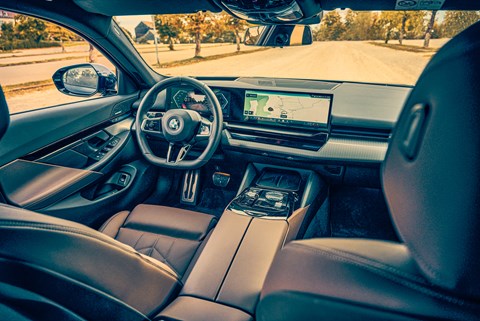
You’ll have spotted that we have one petrol and one diesel car here, the 205bhp 520i and the 195bhp E220d. That’s not part of a grand plan, but rather a question of testing what’s available. But experience of current powertrains from both manufacturers suggests that at this non-performance-critical end of the segment the fuel type does not transform the car. When it comes to the fundamentals, they’re directly comparable.
So what is the driving experience like? Is the new 520i still a proper 5-series even though it has grown to 5060mm in length, thereby eclipsing the bigger-looking Mercedes by 111mm? First impression is that the BMW feels firmer and flatter. It also has better traction out of tight corners. Neither the 520i nor the E220d is going to win a prize for outstanding achievements in the noise, vibration and harshness triathlon. Give them stick, and the Benz will protest with louder grumblings and less suave running manners. Give them a long leash, though, and you’ll be rewarded with smoother shifts and a sonorous, unperturbed high-speed purr.
The 195bhp diesel-drinker relays up to 325lb ft of torque to the rear wheels by means of a new eight-speed transmission. The 2.0-litre BMW engine rated at 205bhp and 243lb ft connects to a nine-speed automatic. The more powerful car wins the sprint run by a token 7.5 against 7.6sec, but it loses the top-speed duel by 142 to 148mph.
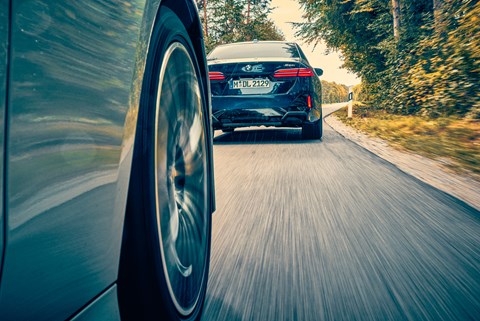
As far as the WLTP fuel economy is concerned, the d eclipses the i by 10mpg or so, but in reality the gap will sometimes be closer. Both four-cylinder engines get mild-hybrid assistance; the Merc’s 23bhp e-motor is slightly beefier than the 18bhp unit fielded by its competitor. Unless your name is Avis or Hertz, a 5-series powered by the most basic 2.0-litre engine isn’t likely to top your wish list; ditto a pretty modest Merc diesel. But the mild-hybrid upgrade is a help in both cases because it speeds up the throttle response and fills the turbo hole. Once you’re on a roll, the number of cylinders is no longer a dynamically critical factor.
These engines have different characters, obviously. Redlined at 4400rpm, the diesel delivers its peak power at a leisurely 3600rpm, while the torque curve peaks between 1800 and 2800rpm. Part-throttle waftaholics should be able to siphon 1000 miles out of the 66-litre tank, although dedicated lead-footers will be pleased to top 400 miles. During our vigorous test the Mercedes returned 30.4mpg against the BMW’s 26.4mpg.
The 520i sounds notably more civilised and runs a full octave quieter than the gruffer and less gentlemanly Mercedes. Although the twin-scroll turbo-boosted four can spin to 7000rpm, the maximum output is present in full force from a conveniently low 4400 to a buzzing 6500rpm. The peak twist action of 243lb ft falls 82lb ft short of the E-Class, but it is on tap all the way from 1500 to 4000rpm. This torque current is less deep but wider, and it builds up its momentum more quickly than the leisurely diesel, which delivers the goods portioned by that nine-speed transmission within a much smaller sweet spot. It is thus easier to catch the Benz on the wrong foot than the BMW, which picks up the pace more eagerly but needs to be revved harder to unfold its full strength, for which you pay at the pumps. On the way there, the BMW’s engine is both more responsive and a tad more energetic between 70 and 125mph.
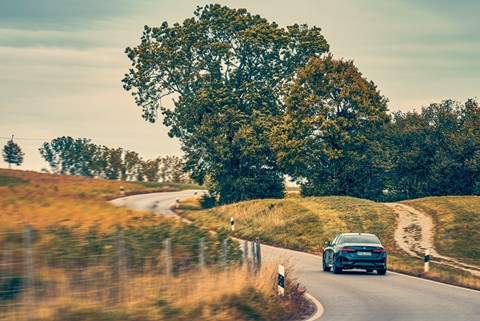
Even though the BMW can’t really pull away from the Mercedes in a straight line, it makes up time through the winding bits of the journey, where the even more tenacious roadholding and the flatter cornering posture pay off as long as the roads are reasonably smooth. On rougher surfaces, however, the Benz begins to catch up again, although the surplus torque and the nose-heavier diesel engine make it simultaneously harder to put the power down without delay. Overall, the E-Class is less chuckable and less firmly planted, but the difference is not night and day.
The helm of the Benz feels lighter and not quite as intimately connected as the sharper and meatier rack-and-pinion unit of its competitor. This effortlessness extends to the brakes, which are attentive and ultimately just as strong in the Mercedes, but in the BMW they are even quicker on the case and more determined early on in the deceleration process when bonding commences and that all-important driver confidence is established.
The E-Class voluntarily softens the edges in favour of a cushier ride, smoother and more progressive dynamics, a more forgiving approach to fast cornering, a broader margin of error and a handling ⊲ attitude that is both perfectly involving yet always on the safe side. While the BMW prefers to be pushed to shine, the Benz feels more at home in a relaxed orbit.
For premium saloons like this duo, dynamic pleasure has always been just part of the appeal. Not long ago features such as leather and wood, a sophisticated sound system and perhaps a fancy sunroof signalled that your car was a bit special, and to the manufacturer meant extra revenue. Now the makers’ additional profit is primarily earned by elaborate assistance systems, novel digital features and trick emotional enhancements of the all-important customer journey, as distinct from the pleasures of the actual journey involved in driving the thing.
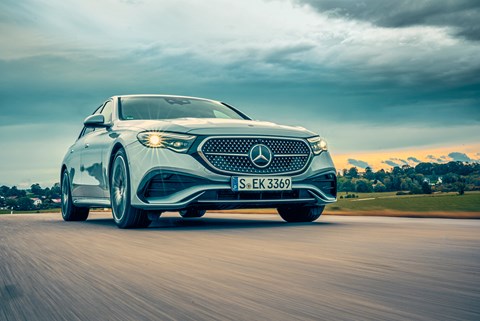
So when you walk towards these cars with the keys in your pocket, they will not merely unlock themselves but also switch on their logo puddle lights, put an LED spell on the approach path, play a welcome tune when the door opens and stage a brief multimedia show as the driver sits down and buckles up. And it doesn’t stop there – far from it. Mood-sensitive active ambient lighting, subtle fragrances, automatically adapting seats, heated door panels, personalised sound patterns, up to five cameras surveying the cabin for the occupants’ every whim – it’s all available in both cars.
You can also get the car to turn up the heat to a given temperature at a certain time, switch on the six o’clock news unprompted, call home 10 minutes prior to your arrival, and perform many other inessential jobs. In the BMW, the pointedly futuristic curved display multi-tasks as widescreen canvas for the peculiar square-bracket instruments, the usual multimedia regalia, the full connectivity works and a herd of apps.
New additions include a gaming library, a football app complete with video ticker and live matches, and the so-called AirConsole good for up to four players who can use their smartphones as controllers after hooking them up via a QR code. These both qualify for membership of that growing group of cars in which it almost comes as a shock that the driver must still push a button to start the engine and pull a lever to select the direction of travel.
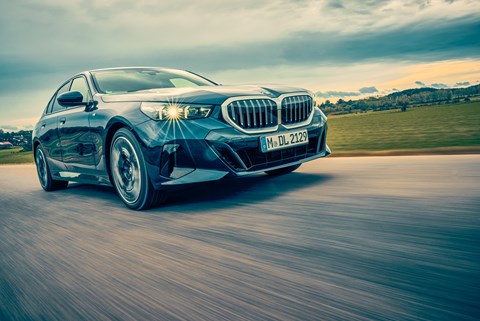
Big changes are in progress, and even these relatively conventional newcomers – look, no plugs! – are part of the trend. The modern motor car is no longer happy being a largely passive tool in the hands of the driver. Instead, it wants a piece of the action. Step by step, this may one day lead to cars becoming wholly autonomous transportation appliances, taking full responsibility when conveying its load safely from A to B. A glimpse of this possible future comes with BMW’s latest Driving Assistant Professional system, not currently offered in the UK, which can autonomously execute lane changes at up to 81mph. There is no need to leave your hands on the wheel, but you must keep your eyes on the road or the system will quit. All it takes to trigger an overtaking move is the okay from numerous cameras and sensors, confirmed by a quick glance in the rear-view mirror. The same procedure steers the car safely back to the slower lane. With the nav active, the system even automatically filters through traffic in time for the chosen exit. Early next year, the E-Class is also expected to receive its Level 2+ type approval.
But for now, both cars very much need a driver, and give plenty for that driver to enjoy.
Mercedes E-Class vs BMW 5-series: the final reckoning
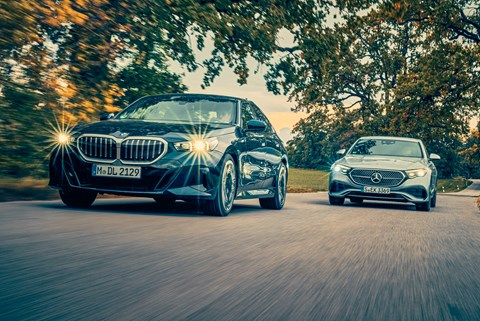
Let’s not lose sight of the basics here. Both contenders are visually appealing, well proportioned, nicely put together and decently equipped. They also both drive well and feel pretty special, in the grand scheme of things. The criticisms we have of them are mostly about the fine margins and the nuances, about the infotainment and availability of a seat massage function. These are both fine cars, proudly maintaining their respective traditions.
The BMW appears more modern, less showy and pleasantly crisp; if you recall fondly your dad’s old S-Class, you’ll love the new E-Class. The Mercedes looks more prestigious and bigger than it is; the 5-series has a slightly longer wheelbase and a trifle more room in the back. Impressively, its animal-free upholstery feels every bit as precious as the hide trim of our E220d test car.
That the boot of the new 520i holds 20 litres less than the 540-litre trunk of its counterpart is in reality less of an issue than the smaller 60-litre fuel tank, which gives the diesel an approximately 30 per cent range advantage. But then if range was a big priority you’d quite likely be looking at the plug-in hybrids.
If you like the sound of the Merc but you couldn’t face owning a diesel in 2024 and beyond, much of what’s good about the E220d would also apply to the petrol-fed 201bhp E200. The engine is not the decider here. It’s more about how the car looks, handles, rides and performs, not what kind of juice it drinks.
And it won’t take long in the real or virtual showroom for you to start developing strong opinions about the exterior styling of both cars, and the interior look and feel. Both cockpits are gleaming, tech-heavy work- and playstations that have been designed with at least one eye on whiling away those miles while the car drives itself, which neither of these actually can yet, or while the battery is recharging which doesn’t apply to these plug-free models.
The E-Class is roomier, homelier, classier in typical Mercedes fashion. In contrast, the 5-series cabin is emphatically contemporary and functional. Despite a record 44 icons the de-contented cockpit still comes across as reduced; from some angles almost barren.
Crowning a winner has seldom been this tough. But when you do what we like doing best – hitting the road for a long, hard drive – the BMW emerges as the contender that satisfies with greater bandwidth and deeper intensity. While the magic carpet trophy belongs to the E220d, the 520i edges the Benz in terms of handling and roadholding. The E-Class is the champion of so many other things, but the 5-series is, true to tradition, the better driving machine.
Mercedes E-Class vs BMW 5-series: the verdict
First place
BMW 5-series
We could make a strong case for the Merc to be first. But when there are two keys to pick from, the enthusiast will grab the one with the roundel.
Second place
Mercedes E-Class
Plusher and roomier the E-Class is a little less refined and dynamically not quite as involving as the 5-series.